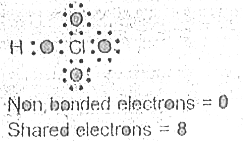Calculate the formal charge on atoms in carbonate (CO2−3) .
To calculate the formal charge on the atoms in the carbonate ion CO2−3, we will follow these steps:
Step 1: Draw the Lewis Structure of CO2−3
1. Count the total number of valence electrons:
- Carbon (C) has 4 valence electrons.
- Each oxygen (O) has 6 valence electrons, and there are three oxygens.
- The ion has a -2 charge, which means we add 2 more electrons.
Total valence electrons = 4+(3×6)+2=4+18+2=24 electrons.
2. Arrange the atoms:
- Carbon is the central atom, and it is bonded to three oxygen atoms.
3. Distribute the electrons:
- Place a double bond between carbon and one oxygen atom, and single bonds between carbon and the other two oxygen atoms.
- Distribute the remaining electrons to satisfy the octet rule for each atom.
The Lewis structure will show one double bond (C=O) and two single bonds (C-O) with the two single-bonded oxygens each having three lone pairs of electrons.
Step 2: Calculate the Formal Charge for Each Atom
The formula for calculating the formal charge (FC) is:
FC=(Number of valence electrons)−(Number of lone pair electrons)−12×(Number of shared electrons)
For Oxygen with Double Bond (O1):
1. Valence Electrons: 6 (for O)
2. Lone Pair Electrons: 2 (1 lone pair)
3. Shared Electrons: 4 (double bond with C)
FC1=6−2−12×4=6−2−2=2(This should be -1)
For Oxygen with Single Bond (O2):
1. Valence Electrons: 6 (for O)
2. Lone Pair Electrons: 4 (2 lone pairs)
3. Shared Electrons: 2 (single bond with C)
FC2=6−4−12×2=6−4−1=1(This should be -1)
For Carbon (C):
1. Valence Electrons: 4 (for C)
2. Lone Pair Electrons: 0 (no lone pairs)
3. Shared Electrons: 8 (4 from double bond and 2 from each single bond)
FC3=4−0−12×8=4−0−4=0
Step 3: Sum the Formal Charges
Now, we sum the formal charges of all the atoms:
- FC1=−1 (O with double bond)
- FC2=−1 (O with single bond)
- FC3=0 (C)
Total formal charge = −1+−1+0=−2
Conclusion
The formal charges on the atoms in the carbonate ion CO2−3 are:
- One oxygen atom has a formal charge of -1,
- Another oxygen atom has a formal charge of -1,
- The carbon atom has a formal charge of 0,
- The last oxygen atom has a formal charge of 0.
- Carbon (C) has 4 valence electrons.
- Each oxygen (O) has 6 valence electrons, and there are three oxygens.
- The ion has a -2 charge, which means we add 2 more electrons.
Total valence electrons = 4+(3×6)+2=4+18+2=24 electrons.
- Carbon is the central atom, and it is bonded to three oxygen atoms.
- Place a double bond between carbon and one oxygen atom, and single bonds between carbon and the other two oxygen atoms.
- Distribute the remaining electrons to satisfy the octet rule for each atom.
FC=(Number of valence electrons)−(Number of lone pair electrons)−12×(Number of shared electrons)
2. Lone Pair Electrons: 2 (1 lone pair)
3. Shared Electrons: 4 (double bond with C)
2. Lone Pair Electrons: 4 (2 lone pairs)
3. Shared Electrons: 2 (single bond with C)
2. Lone Pair Electrons: 0 (no lone pairs)
3. Shared Electrons: 8 (4 from double bond and 2 from each single bond)
- FC1=−1 (O with double bond)
- FC2=−1 (O with single bond)
- FC3=0 (C)
- One oxygen atom has a formal charge of -1,
- Another oxygen atom has a formal charge of -1,
- The carbon atom has a formal charge of 0,
- The last oxygen atom has a formal charge of 0.
Topper's Solved these Questions
- CHEMICAL BONDING AND MOLECULAR STRUCTUREBOOK - CENGAGE CHEMISTRYCHAPTER - CHEMICAL BONDING AND MOLECULAR STRUCTUREEXERCISE - Solved Examples
36 Videos
- CHEMICAL BONDING AND MOLECULAR STRUCTUREBOOK - CENGAGE CHEMISTRYCHAPTER - CHEMICAL BONDING AND MOLECULAR STRUCTUREEXERCISE - Ex 2 .2 Subjective (Intermolecular Forces And H-Bonding)
7 Videos
- ATOMIC STRUCTUREBOOK - CENGAGE CHEMISTRYCHAPTER - ATOMIC STRUCTUREEXERCISE - Concept Applicationexercise(4.3)
19 Videos
- CHEMICAL EQUILIBRIUMBOOK - CENGAGE CHEMISTRYCHAPTER - CHEMICAL EQUILIBRIUMEXERCISE - Archives (Subjective)
11 Videos
Similar Questions
Knowledge Check
Formal charge on two O atoms in
 A−1,+1B−1,0C0,+1D−1,−1
A−1,+1B−1,0C0,+1D−1,−1
Calculate the formal charge on each atoms in CO2−4 (per -oxocarbonate ion) .
View SolutionCalculate the formal charge on CI atom in HCIO4
Hint
View SolutionCalculate the formal charge on S in HSO−4 ion
View SolutionCalcuate the formal charge on each atom in SO2−5 (per -oxosulphate ion) .
View SolutionCalculate the formal charge on S in following structure :

View SolutionCalculate the formula mass of potassium carbonate (K2CO3) (Given : Atomic masses : K=39u,C=12u,O=16u)
View SolutionCalculate the formula mass of sodium carbonate (Na2CO3). (Given : Atomic masses : Na = 23 u, C = 12 u, O= 16 u )
View Solution
